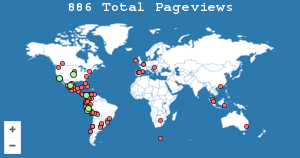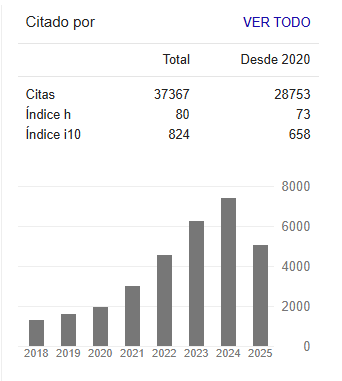Factores influyentes en el comportamiento hacia la compra y la cocreación del valor de marca
Resumen
El comportamiento hacia la compra y la cocreación del valor de marca está influenciada por diferentes factores en las decisiones del consumidor. El objetivo de la investigación fue determinar cuáles son los factores influentes en las decisiones de compra, utilizando un modelo estructural. Bajo un diseño de investigación no experimental explicativo, se aplicó un cuestionario electrónico diseñado especialmente para la investigación a una muestra de 161 estudiantes universitarios (n=18; α=.931; ω=.935) de las carreras profesionales de publicidad, multimedia, comunicación y marketing. Los resultados evidencian a través de la bondad y ajuste del modelo propuesto, niveles razonables de influencia de los factores intervinientes en las decisiones de compra, encontrando relaciones de causalidad estadísticamente significativas. Se concluye que, existe diversos factores que influyen en el comportamiento e impulso conductual hacia la compra y en la cocreación del valor de marca, generando relaciones que van más allá de estímulos cognitivos, afectivos o emocionales y que la sonoridad como elemento clave de la identidad de la marca juega un rol importante, así como, la conexión y la satisfacción del consumidor.
Citas
Candela Llorens, B. (2017). Impacto de la congruencia entre la música y la imagen publicitaria sobre la respuesta emocional y la intención de compra Universitas Miguel Hernádez]. Elche. http://dspace.umh.es/handle/11000/6320
Castello-Martinez, A., & del Pino-Romero, C. (2019). De la publicidad a la comunicacion persuasiva integrada: estrategia y empatia. ESIC Editorial.
Chou, S.-F., Horng, J.-S., Sam Liu, C.-H., & Lin, J.-Y. (2020). Identifying the critical factors of customer behavior: An integration perspective of marketing strategy and components of attitudes. Journal of Retailing and Consumer Services, 55, 102113. https://doi.org/https://doi.org/10.1016/j.jretconser.2020.102113
Dijkstra, T. K., & Henseler, J. (2015). Consistent Partial Least Squares Path Modeling. MIS quarterly, 39(2), 297-316. https://doi.org/10.25300/MISQ/2015/39.2.02
Fornell, C., & Larcker, D. F. (1981). Evaluating Structural Equation Models with Unobservable Variables and Measurement Error. Journal of Marketing Research, 18(1), 39-50. https://doi.org/10.2307/3151312
Gómez Rodríguez, A., & Ortegón-Cortázar, L. (2016). Gestión del marketing sensorial sobre la experiencia del consumidor. Revista de Ciencias Sociales (Ve), XXII(3), 67-83. https://www.redalyc.org/articulo.oa?id=28049146006 (IN FILE)
Graakjær, N. J., & Bonde, A. (2018). Non-musical sound branding – a conceptualization and research overview. European Journal of Marketing, 52(7/8), 1505-1525. https://doi.org/10.1108/EJM-09-2017-0609
Groves, J. (2008). A short history of sound branding. Nomos Verlagsgesellschaft mbH & Co. KG.
Gursoy, D., Ouyang, Z., Nunkoo, R., & Wei, W. (2019). Residents’ impact perceptions of and attitudes towards tourism development: a meta-analysis. Journal of Hospitality Marketing and Management, 28(3), 306-333. https://doi.org/10.1080/19368623.2018.1516589
Gutiérrez-Aguilar, O., Duche-Pérez, A., & Turpo-Gebera, O. (2022). Affective Support Mediated by an On-Line Constructivist Environment in Times of Covid-19. Communication and Smart Technologies, 458-468. https://doi.org/0.1007/978-981-16-5792-4_45
Hair, J., Sarstedt, M., Ringle, C., & Gudergan, S. (2017). Advanced Issues in Partial Least Squares Structural Equation Modeling.
Hair, J. F., Hult, G. T., Ringle, C. M., Sarstedt, M., Castillo Apraiz, J., Cepeda Carrión, G., & Roldán, J. L. (2021). Manual avanzado de Partial least squares structural equation modeling (PLS-SEM). OmniaScience Scholar. https://doi.org/10.3926/oss.37
Hair, J. F., Hult, G. T. M., Ringle, C. M., Sarstedt, M., Castillo Apraiz, J., Cepeda Carrión, G., & Roldán, J. L. (2019). Manual de partial least squares structural equation modeling (pls-sem). OmniaScience Scholar.
Hair Joseph, F., Risher Jeffrey, J., Sarstedt, M., & Ringle Christian, M. (2019). When to use and how to report the results of PLS-SEM. European Business Review, 31(1), 2-24. https://doi.org/10.1108/EBR-11-2018-0203
Hanssens, D. M., Pauwels, K. H., Srinivasan, S., Vanhuele, M., & Yildirim, G. (2014). Consumer attitude metrics for guiding marketing mix decisions. Marketing Science, 33(4), 534-550. https://doi.org/10.1287/mksc.2013.0841
Henseler, J., Ringle, C. M., & Sarstedt, M. (2015). A new criterion for assessing discriminant validity in variance-based structural equation modeling. Journal of the academy of marketing science, 43(1), 115-135. https://doi.org/10.1007/s11747-014-0403-8
Henseler, J., Ringle, C. M., & Sinkovics, R. R. (2009). The use of partial least squares path modeling in international marketing. In R. R. Sinkovics & P. N. Ghauri (Eds.), New Challenges to International Marketing (Vol. 20, pp. 277-319). Emerald Group Publishing Limited. https://doi.org/10.1108/S1474-7979(2009)0000020014
Holbrook, M. B., & Hirschman, E. C. (1982). The Experiential Aspects of Consumption: Consumer Fantasies, Feelings, and Fun. Journal of consumer Research, 9(2), 132-140. http://www.jstor.org/stable/2489122
Huanca, S. C., Aguilar, A. G., Pérez, A. B. D., & Aguilar, O. G. (2021). The internalization of ICT and its influence on emotional states in university students. 2021 16th Iberian Conference on Information Systems and Technologies (CISTI), 1-7. https://doi.org/10.23919/CISTI52073.2021.9476543
Hultén, B. (2011). Sensory marketing: the multi-sensory brand-experience concept. European Business Review, 23(3), 256-273. https://doi.org/10.1108/09555341111130245
Joy, A., & Sherry, J. F., Jr. (2003). Speaking of Art as Embodied Imagination: A Multisensory Approach to Understanding Aesthetic Experience. Journal of consumer Research, 30(2), 259-282. https://doi.org/10.1086/376802
Kumar, V. (2014). Understanding Cultural Differences in Innovation: A Conceptual Framework and Future Research Directions. Journal of International Marketing, 22(3), 1-29. https://doi.org/10.1509/jim.14.0043
Lawson, A. P., Mayer, R. E., Adamo-Villani, N., Benes, B., Lei, X., & Cheng, J. (2021). Recognizing the emotional state of human and virtual instructors. Computers in Human Behavior, 114, 106554. https://doi.org/https://doi.org/10.1016/j.chb.2020.106554
Lee, S. H. N., & Chow, P.-S. (2020). Investigating consumer attitudes and intentions toward online fashion renting retailing. Journal of Retailing and Consumer Services, 52, 101892. https://doi.org/https://doi.org/10.1016/j.jretconser.2019.101892
Moin, S. M. A. (2020). Storytelling for Minds: Neuroscience’s Approaches to Branding. In S. M. A. Moin (Ed.), Brand Storytelling in the Digital Age: Theories, Practice and Application (pp. 41-51). Springer International Publishing. https://doi.org/10.1007/978-3-030-59085-7_3
Sanz Cay, A. (2014). Neuromarketing y Marketing Sensorial: Una aplicación práctica, El Mercado Central de Zaragoza Universidad de Zaragoza]. Zaragoza España.
Shmueli, G. (2010). To Explain or to Predict? Statistical Science, 25(3), 289-310, 222. https://doi.org/10.1214/10-STS330
Singhal, S., & Khare, K. (2015). Does Sense Reacts for Marketing – Sensory Marketing. MKTG: Marketing Manager Behavior (Topic). https://doi.org/10.2139/ssrn.2956779
Yoon, S., & Rottenberg, J. (2019). Why Do People With Depression Use Faulty Emotion Regulation Strategies? Emotion Review, 12(2), 118-128. https://doi.org/10.1177/1754073919890670

Esta obra está bajo licencia internacional Creative Commons Reconocimiento-NoComercial-CompartirIgual 4.0.








.png)






























